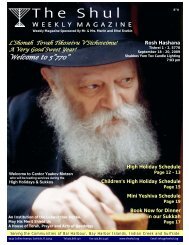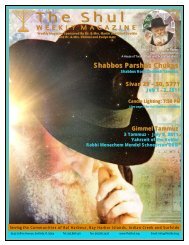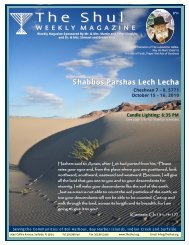You also want an ePaper? Increase the reach of your titles
YUMPU automatically turns print PDFs into web optimized ePapers that Google loves.
Inspiration, Insights & Ideas<br />
Bringing Torah lessons to LIFE!<br />
Continued from p. 11<br />
because you will listen i.e. observe 'eikev' — the six hundred and<br />
thirteen mitzvot which are in the one hundred and seventy-two words<br />
of the Ten Commandments. Thus, your G-d will safeguard for you the<br />
covenant and kindness that He swore to your forefathers."<br />
Alternatively, the Gemara (Yoma 28b) says that our father Avraham<br />
kept the entire Torah, as Scripture states, "eikev asher shama Avraham<br />
bekoli" — "because Avraham hearkened to My voice [kept My charge,<br />
My commandments, My statutes, and My laws] (Bereishit 26:5). In<br />
light of the above, the proof that Avraham kept the Torah may be<br />
deduced from the word "eikev," which refers to the one hundred and<br />
seventy-two words of the Ten Commandments, that contain the six<br />
hundred and thirteen mitzvot of the Torah.<br />
Alternatively, the Gemara (Avodah Zarah 9a) says that the world will<br />
exist for six thousand years. Two thousand of these are utterly void of<br />
Torah, two thousand are years of Torah without Mashiach, and the<br />
last two thousand years will start the era of Mashiach. The first twothousand-year<br />
period concluded when Avraham reached the age of<br />
fifty-two and was introduced to Torah. The second two-thousand-year<br />
period ended one hundred and seventy-two years after the destruction<br />
of the second Beit Hamikdash, and then the era of Mashiach began<br />
(see Rashi).<br />
With the word "eikev," which has the numerical value of one hundred<br />
and seventy-two, the Torah is hinting that "eikev" — one hundred and<br />
seventy-two years after the destruction — "tishme'un" — "you will<br />
hear" — the footsteps of Mashiach.<br />
Science of the Soul?<br />
www.exodusmagazine.org<br />
By: Jonathan Sacks<br />
W hat<br />
<br />
would we do for entertainment<br />
without scientists telling us, with<br />
breathless excitement, that “G‑d did not<br />
create the universe,” as if they were the first to<br />
discover this astonishing proposition?<br />
Stephen Hawking is the latest, but certainly not<br />
the first. When Napoleon asked Laplace, two<br />
hundred years ago, where was G‑d in his<br />
scientific system, the mathematician replied, Je n’ais besoin de<br />
cette hypothese. “I do not need G‑d to explain the universe.” We<br />
never did.<br />
That is what scientists do not understand. There is a difference<br />
between science and religion. Science is about explanation. Religion<br />
is about interpretation. Science takes things apart to see how they<br />
work. Religion puts things together to see what they mean. They are<br />
different intellectual enterprises. They even occupy different<br />
hemispheres of the brain. Science – linear, atomistic, analytical – is<br />
a typical left-brain activity. Religion – integrative, holistic, relational<br />
– is supremely a work of the right-brain.<br />
It is important for us to understand the mistake Professor Hawking<br />
has made, because the mutual hostility between religion and<br />
science is one of the curses of our age, and it is damaging to religion<br />
and science in equal measure. The best way of approaching it is<br />
through the autobiography of Charles Darwin. Darwin tells us that<br />
as a young man he had been impressed with the case for G‑d as set<br />
out by William Paley in his Natural Theology of 1802. Paley<br />
updated the classic “argument from design” to the state of<br />
scientific knowledge as it existed in his day.<br />
Parsha Messages<br />
12<br />
Find a stone on a heath, says Paley, and you won’t ask who designed<br />
it. It doesn’t look as if it was designed. But find a watch and you will<br />
think differently. A watch looks as if it was designed. Therefore it<br />
had a designer. The universe looks more like a watch than a stone.<br />
It is intricate, interlocking, complex. Therefore, it too had a designer,<br />
whose name is G‑d. Darwin, in a simple yet world-transforming<br />
idea, showed how the appearance of design does not require a<br />
designer at all. It can emerge over a long period of time by, as we<br />
would put it today, an iterated process of genetic mutation and<br />
natural selection. So the universe is not like a watch, or if it is, the<br />
watchmaker was blind. Q.E.D.<br />
But whoever thought the universe was like a watch in the first<br />
place? The scientists and philosophers of the seventeenth and<br />
eighteenth centuries. Newton. Leibniz. Laplace. Auguste Comte.<br />
What was wrong about Paley’s argument was not the theology but<br />
the science on which it was based. Good science refutes bad<br />
science. It tells us nothing at all about G‑d.<br />
Professor Hawking has done something very similar, except that this<br />
time he plays both parts. He is both Paley and Darwin, and with<br />
great legerdemain and panache, Hawking II, the good scientist, has<br />
brilliantly refuted Hawking I, the poor theologian. Hawking I was the<br />
person who wrote, at the end of A Brief History of Time, that if we<br />
found science’s holy grail, a theory-of everything, we would know<br />
“why it is that we and the universe exist.” We would “know the mind<br />
of G‑d.” This is so elementary a fallacy that it is hard to believe that<br />
Professor Hawking meant it. We would know how we and the<br />
universe came into being, not why. Nor, in any but the most trivial<br />
sense, would we “know the mind of G‑d.”<br />
The Bible simply isn’t interested in how the universe came into<br />
being. It devotes a mere 34 verses to the subject. It takes fifteen<br />
times as much space to describing how the Israelites constructed a<br />
sanctuary in the desert. The Bible is not proto-science,<br />
pseudoscience or myth masquerading as science. It is interested in<br />
other questions entirely. Who are we? Why are we here? How then<br />
shall we live?<br />
It is to answer those questions, not scientific ones, that we seek to<br />
know the mind of G‑d. Hawking II has now refuted Hawking I. The<br />
universe, according to the new theory, created itself. (This reminds<br />
me of a joke I heard as an undergraduate about a smug business<br />
tycoon:<br />
“He is a self-made man, thereby relieving G‑d of a grave<br />
responsibility”). Should you reply that the universe must be<br />
astonishingly intelligent to have fined-tuned itself so precisely for<br />
the emergence of stars, planets, life and us, all of which are<br />
massively improbable, then the answer is that there is an infinity of<br />
universes in which all the possibilities and permutations are played<br />
out. We struck lucky. We found the universe that contained us.<br />
I first heard this theory from that brilliant and wise scientist, Lord<br />
Rees, President of the Royal Society. He too, as he explains in his<br />
book Just Six Numbers, was puzzled by the precision of the six<br />
mathematical constants that define the shape of the universe.<br />
So unlikely is it that the universe just happened, by chance, to fit<br />
those parameters that he too was forced to suggest the parallel<br />
universes hypothesis. If you hold an infinity of lottery tickets, one of<br />
them is going to win.<br />
That is true, but not elegant. The principle of Ockham’s Razor says:<br />
don’t multiply unnecessary entities. Given a choice between a single














